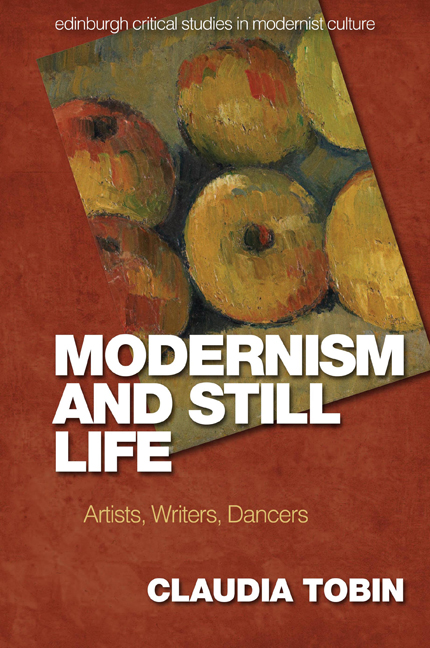Book contents
- Frontmatter
- Contents
- List of Figures and Plates
- List of Abbreviations
- Acknowledgements
- Series Editors’ Preface
- Introduction: ‘Nothing is really statically at rest’: Cézanne and Modern Still Life
- 1 ‘Quivering yet still’: Virginia Woolf, Roger Fry and the Aesthetics of Attention
- 2 Still Life in Motion
- 3 ‘Past the gap where we cannot see’: Still Life and the ‘Numinous’ in British Painting of the 1920s–1930s
- 4 ‘Inactive contemplation’: Wallace Stevens and Charles Mauron
- Conclusion: ‘On the very brink of utterance’: Aldous Huxley, Mark Gertler and Transfigured Things
- Bibliography
- Index
- Plate Section
Introduction: ‘Nothing is really statically at rest’: Cézanne and Modern Still Life
Published online by Cambridge University Press: 08 October 2020
- Frontmatter
- Contents
- List of Figures and Plates
- List of Abbreviations
- Acknowledgements
- Series Editors’ Preface
- Introduction: ‘Nothing is really statically at rest’: Cézanne and Modern Still Life
- 1 ‘Quivering yet still’: Virginia Woolf, Roger Fry and the Aesthetics of Attention
- 2 Still Life in Motion
- 3 ‘Past the gap where we cannot see’: Still Life and the ‘Numinous’ in British Painting of the 1920s–1930s
- 4 ‘Inactive contemplation’: Wallace Stevens and Charles Mauron
- Conclusion: ‘On the very brink of utterance’: Aldous Huxley, Mark Gertler and Transfigured Things
- Bibliography
- Index
- Plate Section
Summary
[Cézanne] raised still life to such a point that it ceased to be inanimate.
Wassily KandinskyThe apples positively got redder & rounder & greener. I suspect some very mysterious quality of potation [?] in that picture.
Virginia Woolf[T]he interior of the picture vibrates, rises and falls back into itself, and does not have a single unmoving part.
Rainer Maria Rilke[N]othing is really statically at rest – a feeling he seems to have had strongly – as when he watched the lemons shrivel or go mildewed, in his still-life group.
D. H. LawrenceStill life presents a paradox. The polarities of ‘stillness’ and ‘motion’ are thrust into uneasy contact as the ‘still’ – eternal yet frozen – art object confronts the rhythms and vitality of ephemeral ‘life’. Strictly, the term refers to a genre of painting that depicts inanimate objects, yet the implications of ‘still life’ in the modern world are more complex and enigmatic. Its very designation conjures word play and duality, gesturing toward what the Italian painter Giorgio de Chirico (1888–1978) described as ‘the double life of a still life’. It is this unsettling and mysterious ‘doubleness’ from which this study takes inspiration.
Still life exists at the borders of private and public space, nature and culture, vitality and mortality. It is, as Bonnie Costello observes, ‘a threshold genre’. These dualities and counter-pressures invest still life with fruitful intensity, and sustain its interest for artists despite a critical tradition that regards it as a minor genre. In what follows, I do not intend to present a history of still life or a genre study, but to recover and extend the scope of its meaning across a broad transcultural and disciplinary range. By examining the shifting terms and characteristics ascribed to the genre in painting, I suggest that we can open up a more nuanced discussion of the ‘still life’ and its significance for modern cultural practices across different media, in literature, painting, sculpture and dance. Further, we can uncover the potential for movement and transformation in the idea of stillness and the ordinary.
Firstly, it will help to briefly trace the rather convoluted etymology of still life as it evolved across European language and culture.
- Type
- Chapter
- Information
- Modernism and Still LifeArtists, Writers, Dancers, pp. 1 - 32Publisher: Edinburgh University PressPrint publication year: 2020



